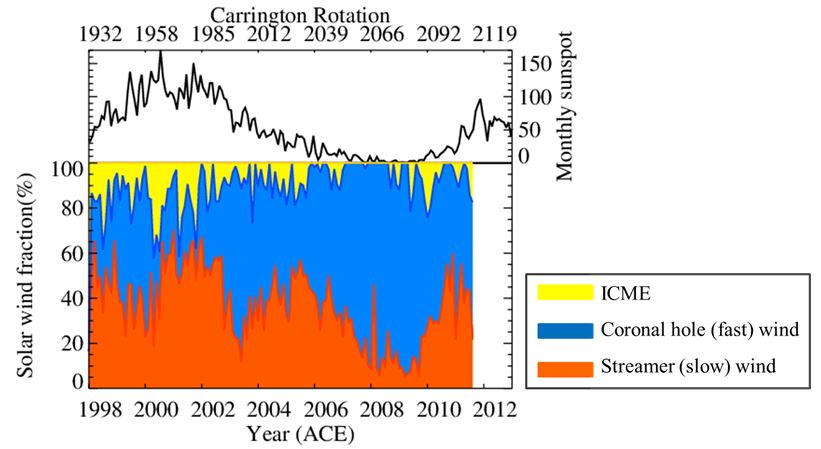
The three types of solar coronal-hole-associated fast and cold wind,
streamer-associated slow and hot wind, and interplanetary coronal mass
ejections ( have been differentiated by their composition and studied using
ACE/SWICS observations from 1998 to 2005 (Zhao et al. GRL 2009 and
ACE News #106).
To continue this earlier study and to complete the picture of the
near-Earth solar wind structure during the whole solar cycle, we extend this
investigation to June 2011, covering the unusual solar minimum between solar
cycles 23 and 24 (2007-2010) and the beginning years of solar cycle 24.ICMEs)
wind
To identify ICME events for our measurements we use the near-Earth ICME list
provided by Richardson and Cane
(/ACE/ASC/DATA/level3/icmetable2.htm).
Then we use the threshold of
O7+/O6+
< 0.145 to identify coronal-hole (fast) from streamer
(slow) wind (Zhao et al. 2009). In the top part of the figure, the monthly
sunspot number (SSN) is plotted versus time (data were downloaded from:
http://sidc.oma.be/sunspot-data/).
In the bottom section of the figure, the
time evolution of the fractions of coronal-hole-associated fast wind (in
blue), streamer-associated slow wind (in orange) and ICME material (in yellow)
are plotted from January 1998 to June 2011.
Continuing with the report in ACE News #106,
here we show that from the
descending phase of solar cycle 23 until the beginning years of cycle 24, the
fractions of these three types of wind evolve dramatically and differently.
Coronal-hole-associated fast wind (blue) is clearly dominant at the solar
minimum phase: it could contribute as much as 90% to the near-Earth
heliosphere in 2008 and 2009. Then, the fraction of this type of wind
decreases quickly after the Sun enters the new cycle (after December 2008).
Streamer-associated slow wind (orange) is less prevalent during solar minimum
than coronal-hole wind, and then its fraction gradually recovers in the
ascending phase of the new cycle, resulting in it finally becoming an
important portion in the heliosphere after June 2010. The occurrence rate of
ICMEs (yellow) is still correlated with the SSN: during the deep solar minimum
in 2007-2009 when the SSN was very low, there were very few ICMEs recorded;
and then the occurrence rate of ICMEs suddenly increased after the new cycle
begins.
Finally, we find that during the entire solar cycle, from the ascending phase
of cycle 23 in 1998 to the ascending phase of cycle 24 in 2011, the total
fractions that the near-Earth coronal-hole-associated fast wind,
streamer-associated slow wind, and ICMEs contribute to the heliosphere are
50.3%, 39.4% and 10.3%, respectively. The fractions of these three types of
wind evolve dramatically with time in very different ways.
This item was contributed by
Liang Zhao and Thomas Zurbuchen of the University of Michigan.
Address questions and comments to
ACE News Archives
Subscribe to ACE News
ACE Homepage
Last modified 28 Aug 2013.